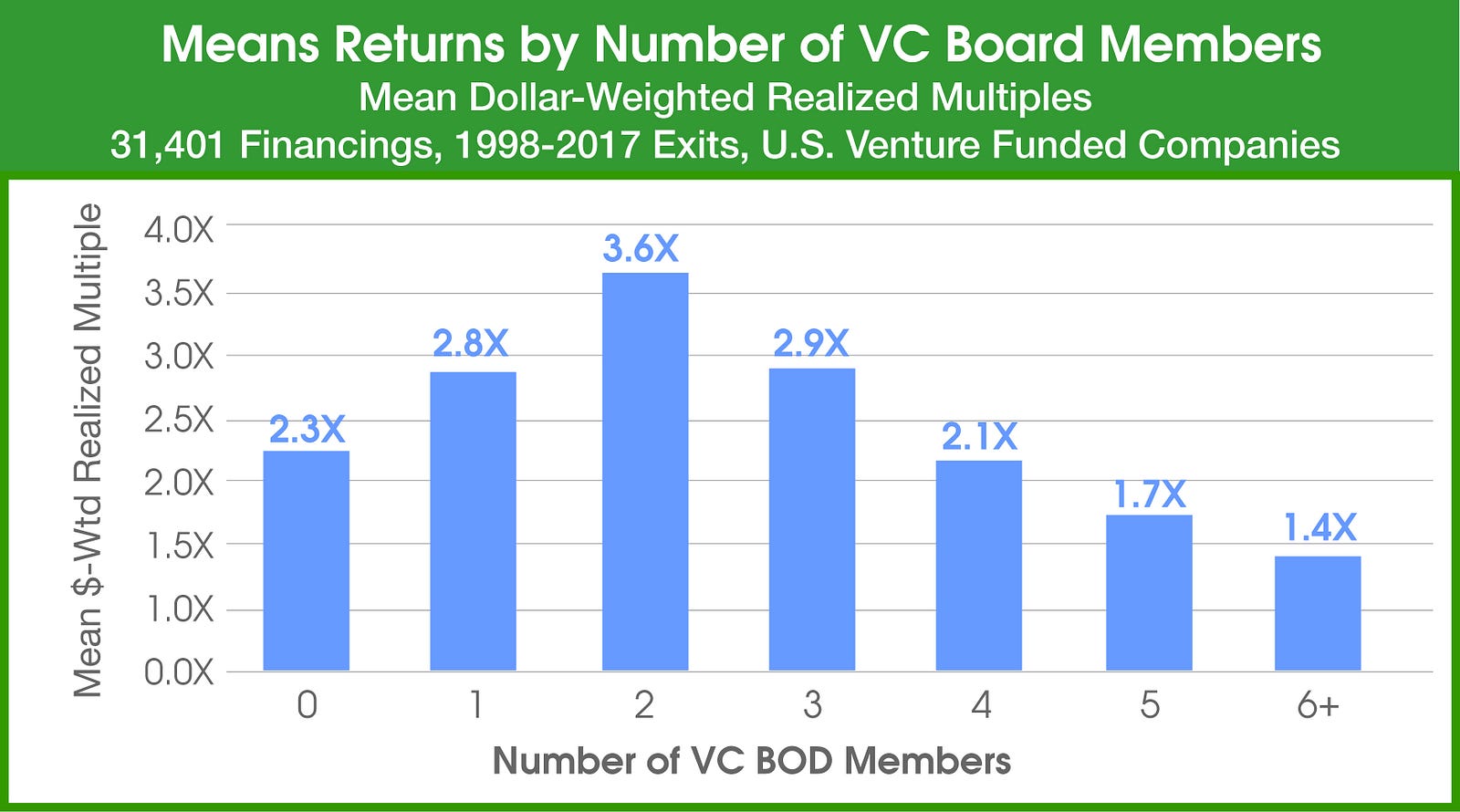Too Many VC Cooks in the Kitchen?


Too Many VC Cooks in the Kitchen?
At Correlation Ventures, we spend a fair amount of time using our proprietary database to identify the telltale signs of successful startups. One question we asked recently is whether there are diminishing returns for adding VCs to the board of directors at venture-backed startups.
Many of us have seen highly effective boards where experienced and engaged VCs work with management and independent directors, offering timely and valuable insights, guidance, and connections. Many of us also have seen highly dysfunctional boards.
So what do the data tell us? Could there be an optimal number of VCs on a board? Could there be too many? Or too few?
Correlation has amassed what we believe is the most complete database of U.S. venture financings and outcomes in the industry. We recently analyzed our database to see if we could draw any conclusions regarding the relationship between the number of VCs on the board and returns.
Our hypothesis was that too many VCs on the board of directors would inversely correlate with outcomes. This is, in fact, what we found.
We analyzed over 31,000 exits that occurred over the past two decades, from 1998 to 2017. We compared the number of VCs on the board at the time of the financing compared with the realized multiples for investors in that round


The above result could, of course, be explained by the fact that early stage investments tend to outperform later stage investments and earlier stage companies tend to have fewer VC board members. Or, perhaps, that industry sectors or time periods associated with fewer board members simply outperformed. However, this is not what we found.
Financing rounds with larger VC boards underperformed even when we controlled for investment stages, industry groups, and time periods.
In fact, the following broad conclusions held within each investment stage, industry group, and time period we evaluated:
· Financing rounds with 4 or more VCs on the board underperformed those with fewer VCs
· Series A financing rounds with 3 or more VCs on the board underperformed those with fewer VCs
If larger VC boards tend to underperform, how often do we see large VC boards in U.S. venture-funded companies? More than a quarter of the time.
Specifically, 28% of VC boards in financings exiting over the past decade had four or more VCs. For Series A financings, 29% had three or more VCs on the board.
While large VC boards inversely correlate with outcomes, so do boards with zero VCs. The data shows that venture-funded company boards with some (2 or 3) VCs outperformed those with no VCs. Over the past decade, 22% of all financings and 24% of Series A financings had no VCs on the board.
The hypothesis for why financings with some VCs on the board outperformed those with no VCs can be heard in any VC pitch: a VC’s willingness to devote his or her time to the company signals a high level of conviction and experienced VCs are able to add value.
But what is the hypothesis for why large VC boards underperform? Perhaps the conventional wisdom that “too many cooks in the kitchen spoil the soup” applies.
My co-founder Trevor Kienzle and I have each served on both functional and dysfunctional boards during 20+ years as VCs and before that as entrepreneurs. We’ve also discussed this topic with many other experienced VCs and management teams. The consensus appears to be that boards with too many VCs can create too much distraction for CEOs and senior management teams. They must devote valuable time to managing boards rather than focusing that time on other mission-critical tasks, such as acquiring their next customers, making progress on the product, or hiring key additions to the team. Also, the larger the number of VCs, the higher the likelihood of conflicting agendas. Finally, it may be the case that at some point incremental board positions would often be better filled by independent directors with highly targeted relevant expertise versus another VC.
Correlation is not causation. Before any of us act on these findings and go remove VCs from our boards, we should remind ourselves of this fact. For a given company, reducing the number of VCs on the board from, say, five to three would not necessarily increase the expected returns for that company.
A more fundamental and causal factor (for example, syndicate size or round size) might exist that happens to correlate to the number of VCs on the board but would not be impacted by a change in the number of board members.
Despite this caveat, these findings should give both entrepreneurs and VCs pause when they are creating boards with either zero or large numbers of VCs. The data shows that, on average, these companies have underperformed.
________________________________________________________________
If you are entrepreneur raising or working with a team that is closing a round, we would value any introductions where we might be helpful as a co-investor. By the way, we add value, but don’t take board seats.


Correlation Ventures is the predictive analytics pioneer in the venture capital industry and the industry’s leading co-investor. With more than $360 million under management, we’re one of the most active U.S. venture investors, investing in about two to three new investments a month. Over the last five years, we’ve invested in over 185 companies. Selected portfolio companies include: AlienVault, Bluevine Capital, Casper, Optimizely, Personal Capital, Sun Basket, Galera, Synthorx, and Upstart. Correlation offers a dramatically better option for lead investors, syndicates, and companies seeking additional venture capital to fill out a round. We offer the most rapid, convenient, and reliable source of co‐investment capital in the industry; for example, committing to make investment decisions within two weeks or less. Correlation is backed by leading institutional investors.
________________________________________________________________
For more, please follow us on Twitter & LinkedIn.
My other stories:
